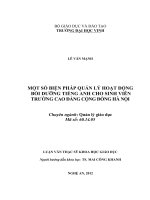Nghiên cứu hành động về việc kết hợp kỹ năng phát âm trong các hoạt động nói tiếng Anh của sinh viên trường Cao đẳng Du lịch Hà Nội
Bạn đang xem bản rút gọn của tài liệu. Xem và tải ngay bản đầy đủ của tài liệu tại đây (1.12 MB, 67 trang )
VIETNAM NATIONAL UNIVERSITY, HANOI
UNIVERSITY OF LANGUAGES AND INTERNATIONAL STUDIES
FACULTY OF POST – GRADUATE STUDIES
*****************
TRẦN THỊ THU HÀ
INTEGRATION OF PRONUNCIATION PRACTICE INTO
SPEAKING ACTIVITIES: AN ACTION RESEARCH AT HANOI
TOURISM COLLEGE
Nghiên cứu hành động về việc kết hợp kỹ năng phát âm trong các hoạt
động nói tiếng Anh của sinh viên trường Cao đẳng Du lịch Hà Nội
M.A. MINOR PROGRAMME THESIS
Field: English Teaching Methodology
Code: 60140111
HANOI – 2013
VIETNAM NATIONAL UNIVERSITY, HANOI
UNIVERSITY OF LANGUAGES AND INTERNATIONAL STUDIES
FACULTY OF POST – GRADUATE STUDIES
*****************
TRẦN THỊ THU HÀ
INTEGRATION OF PRONUNCIATION PRACTICE INTO
SPEAKING ACTIVITIES: AN ACTION RESEARCH AT HANOI
TOURISM COLLEGE
Nghiên cứu hành động về việc kết hợp kỹ năng phát âm trong các hoạt
động nói tiếng Anh của sinh viên trường Cao đẳng Du lịch Hà Nội
M.A. MINOR PROGRAMME THESIS
Field: English Teaching Methodology
Code: 60140111
Supervisor: Associate Prof. Vo Dai Quang, Ph.D.
HANOI – 2013
i
STATEMENT OF THESIS ORIGINALITY
I, Trần Thị Thu Hà, certify that the thesis “Integration of pronunciation
practice into speaking activities: An Action Research at Hanoi Tourism College”
submitted in partial fulfillment of the requirements for the degree of Master of Arts
is the result of my own, except otherwise is acknowledged.
Tran Thi Thu Ha
Hanoi, 2013
ii
ACKNOWLEDGEMENTS
At the completion of this thesis, I would like to express my deep gratitude to
my supervisor, Assoc. Prof. Dr. Vo Dai Quang, for his continuous assistance,
guidance and critical comments at every stage of the study.
I also wish to acknowledge my indebtedness to all the lectures provided by
all the teachers during the M.A course, who have helped me to fulfill this thesis.
Finally, I would like to thank my mother, my colleagues and my friends for
their encouragement, understanding and kind-hearted assistance in completing this
research.
iii
ABSTRACT
Speaking a second language involves different skills such as grammar,
vocabulary, and so on. Pronunciation plays a very important role in English
Language Teaching. This action research is an attempt to investigate the effects of
the integration of pronunciation practice into speaking activities on the students‟
achievement in speaking skills and give some pedagogical implications for the non-
major first year students at Hanoi Tourism College. On integrating pronunciation
into speaking activities in oral lessons, we have discovered that activities structured
by integrating pronunciation practice can help to improve students‟ intelligibility
and achievement in speaking performance. In addition, some helpful techniques of
integrating pronunciation into activities have been realized with a view to improve
the quality of teaching the speaking skill.
iv
TABLE OF CONTENTS
STATEMENT OF THESIS ORIGINALITY i
ACKNOWLEDGEMENTS ii
ABSTRACT iii
TABLE OF CONTENTS iv
LIST OF ABBREVIATIONS vii
LIST OF TABLES viii
LIST OF CHARTS ix
PART A: INTRODUCTION 1
1. Rationale to the study 1
2. Aims and objectives of the research 2
3. Research questions for the study 2
4. Scope of the research 3
5. Significance of the research 3
6. The design of the study 3
PART B: DEVELOPMENT 5
CHAPTER 1: LITERATURE REVIEW 5
1.1. Review of previous studies about integrating pronunciation into speaking activities 5
1.2. Pronunciation in English language teaching 8
1.2.1. What is pronunciation? 8
1.2.2. The importance of pronunciation in English language teaching 10
1.3. Speaking skill in English language teaching 10
1.3.1. What is speaking skill? 10
1.3.2. The importance of speaking skill in English language teaching 11
1.4. Factors affecting the integration of pronunciation into speaking activities 11
1.4.1. Teachers 12
1.4.2. Learners 13
v
1.4.3. Learning environment and text books 14
CHAPTER 2: METHODOLOGY 15
2.1. Current situation of English teaching and learning at Hanoi Tourism College 15
2.1.1. Students and Teachers 15
2.1.2. The teaching facilities and the teaching materials 17
2.1.3. Course and syllabus 17
2.2. An action research 18
2.3. Research hypothesis 19
2.4. Subjects 19
2.5. Data collection instruments and procedure 20
2.5.1. Audio-Recording 20
2.5.2. Classroom observation 21
2.6. Data analysis techniques and procedure 22
2.7. Data analysis 22
2.7.1. The Pre-Test 23
2.7.2. Intervention 29
2.7.3. The Post-Test 34
CHAPTER 3: FINDINGS AND DISCUSSIONS 39
3.1. Finding 1 and comments on this finding 39
3.1.1. Finding 39
3.1.2. Comments 39
3.2. Finding 2 and comments on this finding 40
3.2.1. Finding 40
3.2.2. Comments 40
3.3. Finding 3 and comments on this finding 40
3.3.1. Finding 40
3.3.2. Comments 41
PART C: CONCLUSION 42
1. Summary of the main points presented in the thesis 42
2. Concluding remarks on each of the thesis objectives 42
2.1. Concluding remarks on objective 1 42
vi
2.2. Concluding remarks on objective 2 43
3. Limitations of the study 44
4. Suggestions for future study 44
PART D: REFERENCES 45
PART E: APPENDICES I
APPENDIX 1: PRE-TEST I
APPENDIX 2: MATERIALS USED IN THE SPEAKING LESSON WITH STRESS AT THE
SUPRASEGMENTAL LEVEL IV
APPENDIX 3: MATERIALS USED IN THE SPEAKING LESSON WITH RHYTHM AND
INTONATION PATTERNS V
APPENDIX 4: POST-TEST VII
vii
LIST OF ABBREVIATIONS
AMEP Adult Migrant English Program
EFL/ESL English as a Foreign Language/ English as a second language
ELT English Language Teaching
HTC Hanoi Tourism College
VNU Vietnam National University – Hanoi
viii
LIST OF TABLES
Table 1 Word stress
Table 2 Sentence stress: Conversation 1-Emphasizing added details
Table 3 Sentence stress: Conversation 2 – Emphasizing important words
Table 4 Intonation: Conversation 5 - Intonation in making suggestions
Table 5 Intonation: Conversation 6 - Tones in new and old information
Table 6 Intonation: Conversation 8 - High tone
Table 7 Word stress
Table 8 Sentence stress: Conversation 1 - Emphasizing added details
Table 9 Sentence stress: Conversation 2 - Emphasizing important words
Table 10 Intonation: Conversation 5 - Intonation in making suggestions
Table 11 Intonation: Conversation 6 - Tones in new and old information
Table 12 Intonation: Conversation 8 - High tone
ix
LIST OF CHARTS
Chart 1: Text 3: Rhythm and punctuation
Chart 2: Text 4: Rhythm and pauses
Chart 3 Intonation: Conversation 7 - Continuing or finishing tones
Chart 4 Text 3: Rhythm and punctuation
Chart 5 Text 4: Rhythm and pauses
Chart 6 Intonation: Conversation 7 - Continuing or finishing tones
1
PART A: INTRODUCTION
1. Rationale to the study
As a teacher of English at present and a long- term learner of English in the
past as well, I can see that pronunciation is one of the most important part for
language learners. Pronunciation is the key element for the learners to understand
what others talk to them, and to communicate successfully with other people. Many
learners of English language have major difficulties with English pronunciation
even after years of learning the language. This often results in them facing
difficulties in areas such as finding employment (Fraser, 2000a). The fault which
most severely impairs the communication process in EFL/ESL learners is
pronunciation, not vocabulary or grammar (Hinofotis & Baily, 1980). Davis (1999)
stated that an area of concern and one of the top priorities of ESL students after
completing elementary English courses is pronunciation. For these reason, it is very
important for them to quickly learn how to pronounce sounds, words, sentences as
well as stress, intonation exactly. Terrible pronunciation leads to occasional
misunderstanding. Therefore, words and sentences must be repeated due to serious
errors in pronunciation (still sounds like steel and ship sounds like sheep), word
accent (words are frequently accented on the wrong syllable, e.g., “content”
meaning “pleased, satisfied” versus “content” “that which is contained”), and
sentence pitch (statements have the „melody‟ of questions, etc.). The student needs
to know that improving pronunciation may have greater significance and
importance as it supports some aspects like listening comprehension, spelling,
reading, and grammar (Wong, 1993). Many studies have shown the strong links
between precise pronunciation and speaking well. However, teaching pronunciation
in university or college is not really effective or nearly neglected during the process
of teaching, whereas four skills (listening, speaking, reading, writing) are the main
emphasis.
2
While English is really important in almost every field of our life such as:
economy, technology, science, education, trade, tourism and etc…, there are much
more difficulties in teaching and learning English especially in teaching and
learning pronunciation. At Hanoi Tourism College in particular, difficulties come
from inconvenient working conditions like not well-equipped devices, low level
students and too large classes, as a result, it‟s hard for students to study.
In addition, the popular method here is that teachers pronounce new words
and students repeat them during speaking periods. However, the disadvantage is the
pronunciation of teachers may not be really exact or repetition of students is not the
same as what they hear from teachers. Therefore, the best way to help students to
pronounce a word exactly and be able to apply the proper pronunciation to speaking
is to teach them how to pronounce a word with phonetic and stress.
2. Aims and objectives of the research
This study is aimed to enhance the quality of English pronunciation of the
first year students of non-major English at Hanoi Tourism College.
The first and foremost objective of the study is by virtue of the students. In
addition, the research is expected to use as a source of reference for teachers of
English on the teaching of speaking skills, especially for those who care
pronunciation, one of the important elements which help to deal with listening and
speaking.
To be more specific, in realizing the study, the main objectives are:
- To investigate the effects of the integration of pronunciation practice
into speaking activities on the students‟ achievement in speaking skills.
- To give some pedagogical implications for further development.
3. Research questions for the study
The purpose of the study is to find the answers to the following research
questions:
3
1. What are the effects of integrating pronunciation into speaking
activities on students‟ achievement?
2. What are possible pedagogical implications for further development?
4. Scope of the research
This research focuses on studying the effectiveness of integrating
pronunciation into speaking activities to improve English pronunciation of the first
year students of non-major English at Hanoi Tourism College. In my research, I just
focus on suprasegmentals of pronunciation including stress, rhythm and intonation
in role – playing activity in speaking lessons.
5. Significance of the research
The findings of the thesis will be useful not only to the researcher but also to
teachers and students of HTC. They will contribute to the quality of teaching and
learning pronunciation and speaking at HTC.
Also, with good and intelligible pronunciation, the students‟ self-confidence
will be increased and enables them to better understand their instructors, follow the
news on TV or the radio more easily, or join English conversations, class
discussions, role-plays, etc.
6. The design of the study
The study is divided into three parts, which are presented as follows.
Part A is the introduction, which states the rationale to the study, the aims
and objectives, research questions and the scope as well as the significance and
design of the study.
Part B, including three chapters, reports on the main contents of the study:
Chapter one – Literature review - presents an overview of theoretical
issues of pronunciation discussed and analyzed by prominent and high-qualified
ELT experts and researchers. The focus is exclusively devoted to pronunciation and
speaking.
Chapter two – Methodology – describes how we have carried out the study
of the Faculty of Foreign Languages for Tourism at Hanoi Tourism College. Sub
4
steps in this process consist of observing the learning situation, collecting data,
analyzing data and summarizing findings.
Chapter three – Findings and Discussions – deal with the summary, the
findings as well as the comments for each finding.
Part C is the conclusion where we summarize all the main contents of the
study, give remarks on objectives, limitations of current research and show
suggestions for further studies.
Besides, there are also appendixes in which supplementary materials and list
of references are provided.
5
PART B: DEVELOPMENT
CHAPTER 1: LITERATURE REVIEW
This chapter is concerned with some of the most important issues in theory
of pronunciation and speaking in general and in language teaching in particular. The
main features will be taken into consideration, namely, review of previous studies
about integrating pronunciation into speaking activities, theoretical background of
pronunciation and theoretical background of speaking, the language skill into which
pronunciation is intended to be integrated.
1.1. Review of previous studies about integrating pronunciation into
speaking activities
There have been various arguments and support for the integration of
pronunciation practice into oral communication. Morley (1998) stated that
pronunciation plays an important role in overall communicative competence. Yong
(2004) suggested that from the traditional ways of learning English, students
neglected the basic knowledge of speaking. This may have been enough to meet the
demands of English in the years when we had less communication with foreign
countries. However, oral communication began to be more important when they
arrived in this century with extended forms of communication with Western
countries. Yong (2004) asserted that understanding by reading or writing would no
longer be sufficient for the development of the economy and that communicating
face to face personally or through the internet needed to be understood.
The central issue of pronunciation teaching is how to help students speak
accurately and fluently in speaking classes. One aspect of this issue is what should
be taught in class. Earlier teaching approaches focused on the segmental features of
pronunciation, while more recent approaches have emphasized supra-segmental
features such as sentence rhythm and intonation. However, this debate has never
reached a conclusion. The growing trend in today‟s pronunciation curriculum
design is to integrate both the most important segmentals and suprasegmentals
appropriately in one course. Another aspect of the issue is how to teach effectively.
6
Along with the development of instruction approaches, traditional teaching methods
and techniques have been advocated or challenged during different times while new
methods and techniques have been created. A more balanced view today, as
represented by Celce - Murcia et al., (1996), is to use traditional pronunciation
techniques as a starting point of class and later have students move to more
communicative classroom tasks.
In recent years, there has been a greater emphasis on teaching competent
pronunciation, especially in ESL/EFL classrooms. This is due to the increasing
realization that poor pronunciation can cause serious problems for learners, such as
communication breakdowns, anxiety, and discrimination (Morley, 1998). Yet
English pronunciation is neglected in classrooms throughout the world today,
including Asia. One of the reasons that it is neglected or ignored is because not
many English pronunciation teaching strategies or techniques are available to
teachers in the classroom (Wei, 2006).
Fraser (1999) added that in the quest for effective teaching, it is worth
diagnosing carefully the nature of the difficulties that may be encountered. There is
a significant skill component for learners. Pronunciation is not just a cognitive
„knowing-that‟, it is also a physical „knowing-how‟, similar to playing a sport or
musical instrument. Learners need motivation and time to really practise
pronunciation. It is worth spending class time discussing with learners their own
ideas about what is involved in learning pronunciation.
Jones, Rusman, and Evans (1994) found that students with prior exposure to
phonological rules and principles, although they do not always produce more
accurate pronunciation, seem to be better equipped to assess their own speech and
to be more aware of their particular problems. Concurrently, there was a shift from
specific linguistic competencies to broader communicative competencies as goals
for teachers and students (Morley, 1991). Morley states the need for the integration
of pronunciation with oral communication, with more emphasis from segmentals to
suprasegmental, more emphasis on individual learner needs, and meaningful task-
7
based practice and introducing peer correction and group interaction (Castillo,
1990). Research has shown that teaching phonemes is not enough for intelligibility
in communication. With the emphasis on meaningful communication and Morley‟s
(1991, p. 488) premise that “intelligible pronunciation is an essential component of
communication competence”, teachers should include pronunciation in their
speaking courses and expect students to do well in them.
Besides, Levis and Grant (2003) also did a research of integrating
pronunciation into ESL/EFL classrooms. In their research, they emphasized that
teachers have to find effective ways to integrate pronunciation into oral – oriented
classes in the purpose of good communication. They gave 3 principles to “promote
the integration of pronunciation in ways that link features of speech with their
communicative functions rather than ways that promote non-contextualized or
irrelevant work on the sound system”. These principles are: Aim for a Primary
Though Not Exclusive Focus on Suprasegmentals, Maintain a Central Focus on
Speaking in the Class and Pronunciation Instruction Should Fit the Constraints of
the Speaking Task. Also, they suggested 4 activities (a) word clarity in public
speaking, (b) thought groups in storytelling, (c) intonation in conversation, and (d)
focus in comparisons, three first of which help pronunciation features to be
incorporated into speaking tasks intended to aid students develop oral
communication skills. They showed the conclusion as follow.
We have shown ways in which effective use of pronunciation features is crucial for
effective spoken communication. Words must be recognized if listeners are to process
speech. Speech is processed more easily if speakers chunk information in expected ways.
Intonation is essential to management of conversational goals. Important cues about given
and new information and about categories being contrasted with a topic are signaled by
sentence focus (19).
However, those researches above have just shown challenges and solution
for integrating pronunciation into oral activities, but not find whether it meets
teachers‟ abilities and students‟ awareness in particular.
8
1.2. Pronunciation in English language teaching
1.2.1. What is pronunciation?
Pronunciation refers to the phonology of the language – or the meaningful
perception and production of the sounds of that language and how they impact on
the listener (Burns and Claire, 2003, p.5). Similarly, the AMEP Fact Sheets shows
that Pronunciation refers to the production of sounds that we use to make meaning.
Pronunciation is a set of habits of producing sounds. The habit of producing a sound
is acquired by repeating it over and over again and by being corrected when it is
pronounced wrongly. Learning to pronounce a second language means building up
new pronunciation habits and overcoming the bias of the first language (Cook,
1996).
Pronunciation refers to the production of sounds that we use to make
meaning. It includes attention to the particular sounds of a language (segments),
aspects of speech beyond the level of the individual sound, such as intonation,
phrasing, stress, timing, rhythm (suprasegmental aspects), how the voice is
projected (voice quality) and, in its broadest definition, attention to gestures and
expressions that are closely related to the way we speak a language. A broad
definition of pronunciation includes both suprasegmental and segmental features.
Although these different aspects of pronunciation are treated in isolation here, it is
important to remember that they all work in combination when we speak, and are
therefore usually best learned as an integral part of spoken language.
According to Gilakjani (2011), Pronunciation is viewed as a sub-skill of
speaking. Fraser (2000a) explains that being able to speak English includes a
number of sub-skills of which pronunciation is by far the most important (other sub-
skills of speaking include vocabulary, grammar, and pragmatics). She argues that
“with good pronunciation, a speaker is intelligible despite other errors; with poor
pronunciation, understanding a speaker will be very difficult, despite accuracy in
other areas” (Fraser, 2000a, p. 7).
9
Traditional approaches to pronunciation have often focused on segmental
aspects, largely because these relate in some way to letters in writing, and are
therefore the easiest to notice and work on. More recent approaches to
pronunciation, however, have suggested that the suprasegmental aspects of
pronunciation may have the most effect on intelligibility for some speakers. Harmer
(1993) stresses the need for making sure that students can always be understood and
say what they want to say. They need to master “good pronunciation”, not perfect
accents. That is, emphasis should be on suprasegmental features of pronunciation-
not segmental aspects-to help learners acquire communicative competence
(Seferoglu, 2005). Bott (2005) asserts, “In recent years, increasing attention has
been placed on providing pronunciation instruction that meets the communicative
needs of non-native speakers (NNSs) of English. Empirical research and
pronunciation materials‟ writers suggest that teaching suprasegmentals before
segmentals to intermediate and advanced NNSs could be more beneficial in a
shorter period of time (p. 5).
Anderson-Hsieh, Johnson, and Koehler (1992) compared the relative
contributions made to intelligibility by prosody, segmentals, and syllable structure.
Within 11 different language groups, they found that the score for prosody was
most significantly associated with the overall score for pronunciation. In a related
finding, Derwing, Munro, and Wiebe (1998) studied the effects of both segmental
and suprasegmental instruction on learners‟ comprehensibility ratings and
concluded that the latter had a greater effect on performance in communicative
contexts. Usually learners benefit from attention to both aspects, and some learners
may need help in some areas more than in others. One considerable practical
advantage of focusing on suprasegmentals is that learners from mixed L1
backgrounds in the same class will benefit, and will often find that their segmental
difficulties improve at the same time (Fraser, 2001).
10
1.2.2. The importance of pronunciation in English language teaching
Harmer (2007, p. 248) states that “pronunciation teaching not only makes
students aware of different sounds and sound features (and what these mean), but
can also improve their speaking immeasurably”. The process of learning
pronunciation makes learners be aware of the sounds which they are using while
speaking (Harmer, 2007). Pronunciation plays a vital part in successful
communication. When people have intelligible pronunciation, they can comprehend
what others speak as well as use language to make others understand them. Besides
face-to-face communication, they will have abilities to understand information in
foreign languages on mass media such as TV, newspapers, etc. Since then, they will
have more chances to obtain good jobs and enhance their language level.
1.3. Speaking skill in English language teaching
1.3.1. What is speaking skill?
Speaking is one of the most important skills in learning foreign languages.
Bailey and Savage (1991: vii) say “for many people, speaking is seen as the central
skill because of the desire to communicate with others, often face-to-face and in real
time”. Ur (1996) considers speaking intuitively the most important of the four skills:
people who know a language are referred to as “speakers” of that language as if
speaking included all other kinds of knowing; and many if not most foreign
language learners are primarily interested in learning to speak.
According to Brown and Yule‟s (1983:127), speaking skill consists of short,
fragmentary utterance, in a range of pronunciation. There is often a great deal of
repetition and overlap between one speaker and another and speakers usually use
non-specific references. Brown (1994:45) defined that speaking is an interactive
process of constructing meaning that involves producing, receiving and processing
information. When participating in communicative activities, the speaker should
choose the correct vocabulary to describe the things they want to say about, to
11
rephrase or emphasize words to clarify the description to produce the expected
pattern of specific discourse situations.
1.3.2. The importance of speaking skill in English language teaching
Without question, language is a very important means of communication
which can help people to exchange information, show ideas, wishes and desires.
However, to express those thoughts and transfer that information exactly and easy
to understand, we need to consider speaking skill a significant part. Especially, it is
very necessary for teachers and learners to master this skill. Bygate, M. (1987:5)
emphasizes that speaking “is also a medium through which much language is learnt,
and which for many is particularly conductive for learning”. Nunan (1991:279) also
maintains that effectiveness in an oral conversation is evaluated by the competence
to carry out a conversation in the target language. This competence depends on both
students‟ ability and chances to practice at class. If they do not have opportunities to
show themselves through speaking, they cannot develop language ability and even
lose all interest. It is more essential in speaking class that both the teachers and
students pay much attention in organizing and carrying out positive activities,
otherwise, the speaking class can be regarded as a dead class. Brown, G. and Yule,
G. (1992:256) point out that speaking plays an important role in a very transactional
intention, that is, to make clear what they want to say. When speaking well, learners
will have more capacity to learn other skills such as listening, reading and writing.
In addition, speaking also helps them to open their mind to the large world.
To sum up, speaking skill, besides listening, reading and writing skills, plays
a vital role in language teaching.
1.4. Factors affecting the integration of pronunciation into speaking activities
It is obviously that any choice of a method of teaching needs favorable
conditions for effective application. We can consider some factors affecting the
integration of pronunciation into speaking activities as follows:
12
1.4.1. Teachers
1.4.1.1. Teachers’ attitudes and beliefs
Because teachers are trained to teach students and play a main role in a class,
their beliefs are very important in guiding learners to study. They are directly in
relation to the instruction, content and process of teaching students. When they
believe strongly in the effectiveness of a particular approach or method of teaching
and try to carry out it in classroom, they will be confident to use that.
In addition, teachers‟ attitudes are also very important in teaching. In
classroom, teachers play roles as instructors, consultants, supervisors,
communicators and controllers, so their attitudes have much influence on teaching
and learning processes and the results of them after the course.
Although we know very clearly that pronunciation is very important in
speaking, it is usually neglected in oral activities. Teachers‟ attitudes and beliefs
about this matter will help learners be better in communication.
1.4.1.2. Teachers’ qualities and personalities
Besides attitudes and beliefs, teachers‟ qualities and personalities play a vital
part in teaching learners. It is very difficult for students to gain enough knowledge if
their teachers do not have enough. Levis, J. M. & Grant, L. (2003) states that
“Approaches favoring the integration of pronunciation into oral communication
have been espoused for more than 10 years, but teachers have received little clear
direction about how to accomplish this integration”. They also show two
frameworks “In classes devoted to pronunciation, for example, teachers apply the
framework usually by moving from controlled pronunciation practice to less
structured, communicative speaking practice” and “In courses devoted to speaking
or oral communication, teachers apply the framework by moving in the opposite
direction, starting with less structured speaking practice and perhaps moving into
pronunciation”. However, teachers often do vice converse or “address pronunciation
13
unsystematically”. Therefore, it can be seen that teachers always need to enhance
their qualities in knowledge and teaching method.
1.4.2. Learners
1.4.2.1. Learners’ motivation
Motivation often performs two important characters in second language
learning process; it firstly arouses people‟s interest and secondly helps people keep
their enthusiasm. Language learners‟ motivation is basically originated from goals
of various kinds and needs. It is regarded as the fulfillment of the goals and needs.
When learners have high motivation, they will learn harder, which help them have
more chance in having a good job, high position or status.
1.4.2.2. Learners’ attitudes and beliefs
Levis, J. M. & Grant, L. (2003) also maintain that “even when teachers want
to teach pronunciation communicatively, they have little sense of how to weave it
effectively into a listening and speaking or all-skills course so that it consists of
more than ad hoc corrections, but does not take up so much time that the
communicative goals of the course are neglected”. From that, we can conclude that
learners‟ attitudes and beliefs affect how they approach their learning.
Pronunciation is considered one of the most important things in speaking fluently.
Therefore, learners should have right attitudes and beliefs in learning this, which
will aid them to feel confident in communicating with foreigners and have more
chances in the world market.
1.4.2.3. Learners’ anxiety and confidence
Inaccurate pronunciation and having no ideas when speaking to foreigners
are main reasons which make learners feel worried and unconfident in
communication. Language anxiety is one of the characteristics which have a
relationship with learning process. The more anxious students feel, the less their
result in learning is. With anxiety, learners may have difficulties in making normal
14
conversations or expressing spontaneous reactions. When they have confidence,
they will speak English freely. After that, teachers can discover their mistakes in
pronunciation, which helps them to improve speaking skill quickly. Therefore,
teachers should pay more attention in encouraging learners to speak and creating a
comfortable atmosphere in speaking classroom.
1.4.3. Learning environment and text books
The learning environment can greatly influence on their academic
performance. The learning environment can be seen as physical conditions, such as
class size, chairs, desks, tables, lights, boards, computer and projectors. Physical
conditions really affect students‟ learning and their attitudes towards the subject
matter. With enough equipment to serve the learning, learners will have more
interest in training pronunciation and speaking.
In addition, text books and teaching aids can be considered important
resources. Talking about the challenges of integrating pronunciation into speaking
activities, Levis, J. M. & Grant, L. (2003) say that “existing textbooks offer two
primary avenues for integrating pronunciation and speaking instruction. On the one
hand, although current pronunciation-based texts include communicative activities,
most are organized around pronunciation features and are not suitable as primary
texts in oral communication courses. On the other hand, a striking feature of many
speaking-based or integrated-skills texts is the absence of explicit, sustained focus
on pronunciation”. It can be drawn that improving text books is a very vital thing to
help learners overcome the difficulties in pronunciation as well as speaking.









